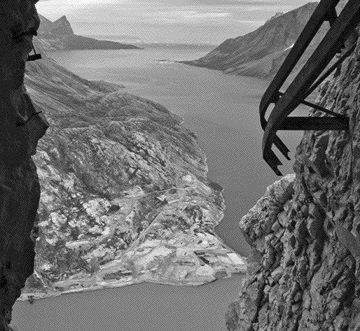The new deposit discovered by Angus & Ross (AGU-L) at the Black Angel zinc-lead mine in western Greenland is now the third-largest zone ever found on the project, following drilling this past summer. And while that discovery is drilled out, progress has been steady on resuming mining at the old Black Angel mine itself.
Drilling this summer has concentrated on the Glacier zone, which the company discovered in 2006 after it was exposed by the retreat of a glacier. Initially seen to be 500 metres long and drilled to a depth of 170 metres, the zone proved to have an inferred resource of 1.5 million tonnes at average grades of 4.76% zinc, 1.67% lead and 10.3 grams silver per tonne. (A small part of that resource — 147,000 tonnes — met indicated standards.)
Drilling during the past field season concentrated on a 465-metre strike length of the deposit, which has expanded to a 650-metre-long mineralized body. Altogether, Angus drilled 7,353 metres in 31 holes on the project this year.
The program yielded the best intersection since the Black Angel deposit was discovered; hole 70 cut 11 metres that averaged 12.2% zinc and 4.5% lead, plus 21 grams silver per tonne.
Overall, the mineralized intersections fell mostly in the 1- to 3-metre range, with zinc grades ranging from 1.9% to 29.2%, and lead grades mainly 2% to 11%, except in high-grade zinc zones where lead grades often fell to near zero. Silver — which naturally tends to correlate with high lead grades — was mainly at grades of 10 to 50 grams per tonne, though quite low in some narrow intersections.
There is a fault mapped elsewhere on the property that is believed to cut off the Glacier zone on its west side, but it has not been located yet and a number of surface showings to the west of the known mineralization will be drill targets next year.
Another thing to be investigated in next year’s drill program is a structural interpretation that suggests Glacier could be either joined to, or faulted off from the Ark deposit, where earlier drilling blocked out an inferred resource of 492,000 tonnes grading 4.73% zinc, 2.2% lead and 20.44 grams silver per tonne. Mineralization at Ark is open to the east, toward Glacier, while Glacier has not been fully defined on the west.
Some of the drilling also investigated a showing 1.2 km south of Glacier, called Lakeshore, but the holes intersected limited mineralization. Other targets on the Lakeshore showing are in the program for 2008.
Field crews also mapped a 72-sq.-km licence area 20 km southwest of Black Angel, near Ukkusissat. Previous operators had drilled the area in 1979 and concluded there was a mineralized zone of about 500,000 tonnes (though grade has not been specified).
Consulting firm Wardell Armstrong is working on a new re- source calculation for the Glacier zone, which should be ready in November.
Also coming in November is the consultants’ final feasibility study on a remnant mining project at the Black Angel mine, which operated between 1973 and 1990. A 2005 prefeasibility study estimated that pillars in the old mine held 2.2 million tonnes grading 9.7% zinc and 3% lead. The company has been looking at using paste backfill, made from mill tailings, to support the workings so that about 80% of the pillar could be removed safely.
Similar pillar recovery is already taking place at Doe Run Co.’s Missouri lead mines, which are geologically similar to the Black Angel deposit. Further geotechnical inspection of Black Angel’s pillars showed they have not degraded since the mine was closed, and 4 km of drifts are still fully usable.
A cable car, bought in Switzerland, is in transit to the port at Maarmorilik, to serve the mine adit at 600 metres above sea level. The mine’s old lower terminal at Maarmorilik is being expanded and the upper portal has been blasted out to accommodate the new cable car. The new system should be running by the middle of next year, in time for early production from the old workings.


Be the first to comment on "Glacier Zone Looking Bigger for Angus & Ross"